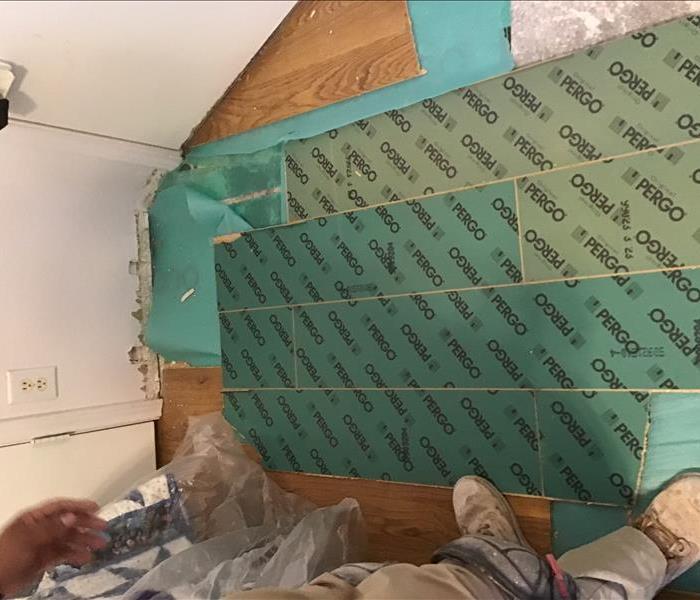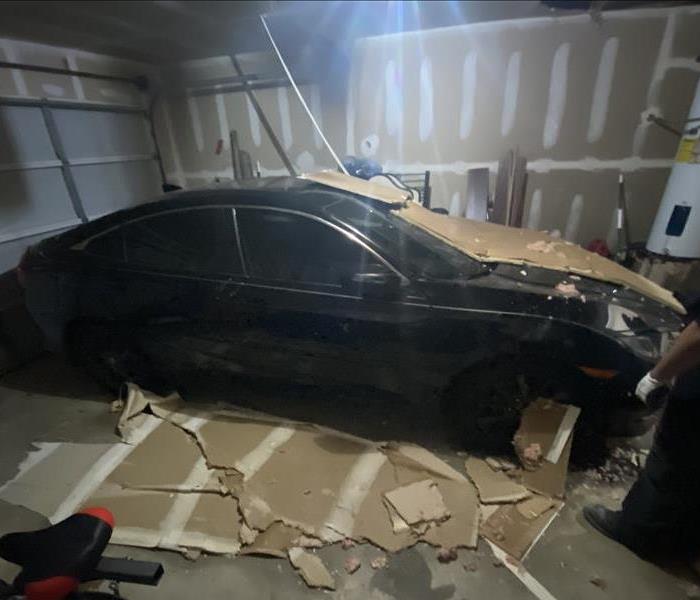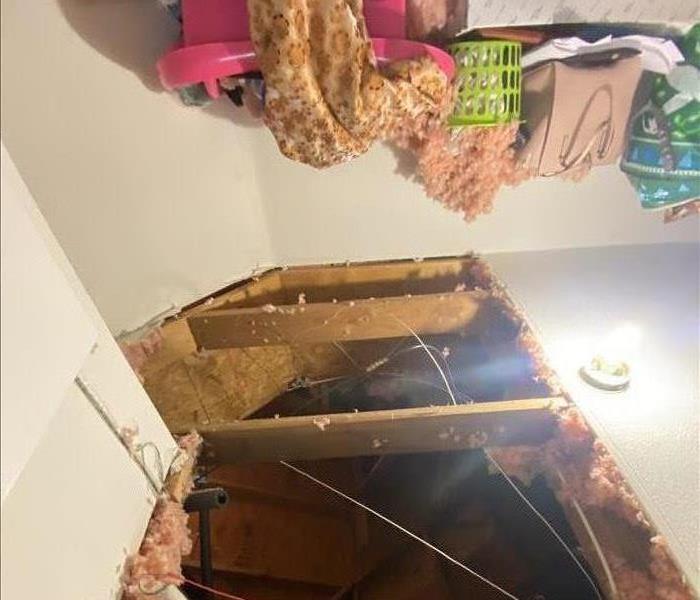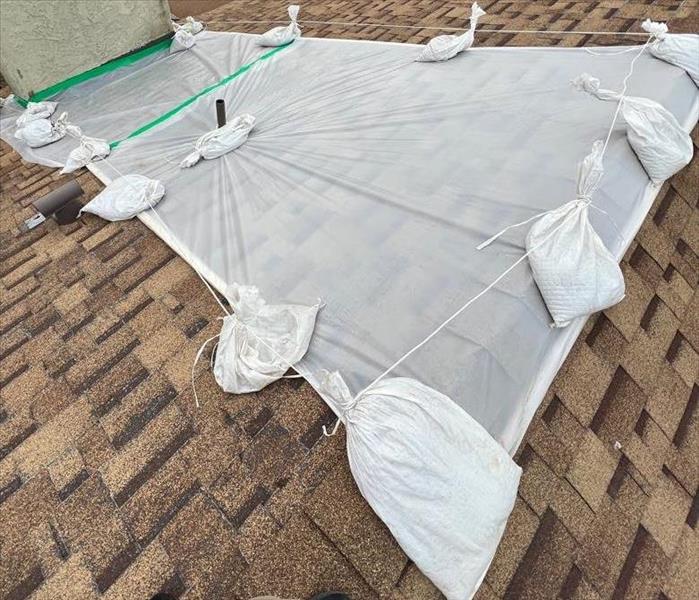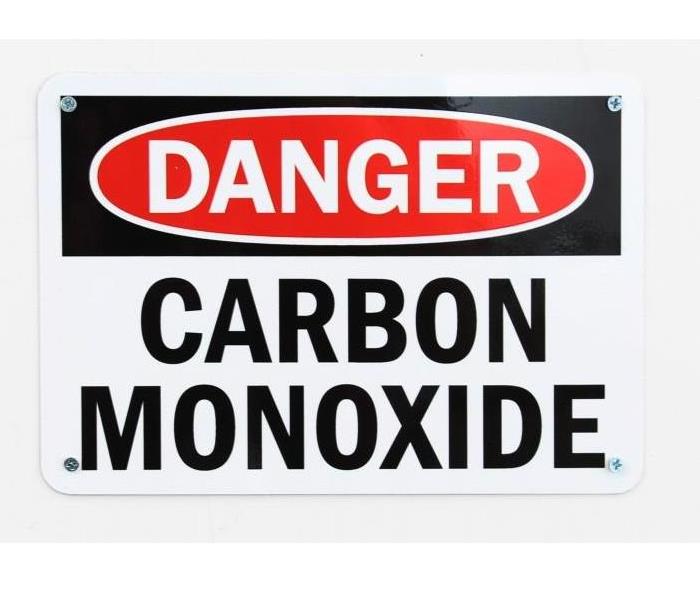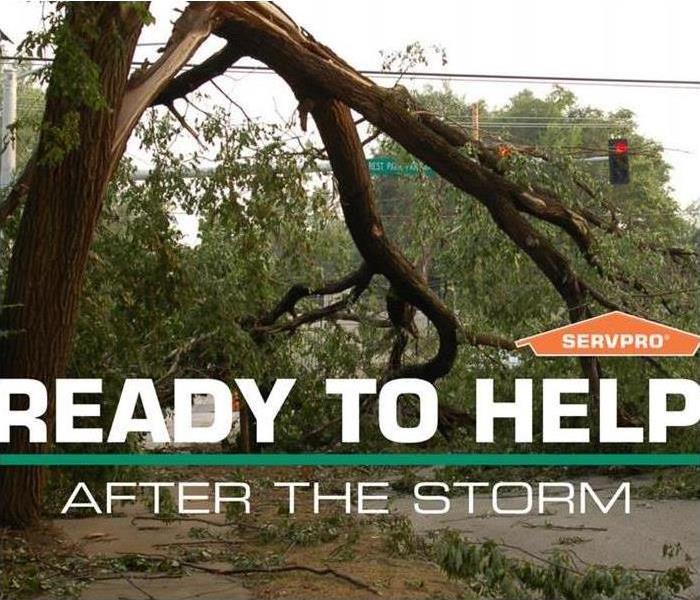Archived Storm Damage Blog Posts
How Storms can Damage Your Home
2/17/2022 (Permalink)
Storms and natural disasters are some of the most destructive and expensive forms of damage to homes across the United States. This can vary from flooding, hail, snow, fire, lightning, or hurricane damage. A great portion of the damage to homeowner’s property is not just from the initial impact. The real concern is in secondary damage which may follow due to structural damage to the property or other concerns such as bacterial growth.
The most important thing to do when your property experiences storm damage is to deal with the aftermath. However, it is imperative to ensure that your property will not experience any further damage after the fact. Getting helped by trained professional this will help you understand the extent of the damage and what your options for restoration and repair are. Remove as much of the standing water as possible until you can get professionals onsite to complete a full extraction of the moisture and water.
- Know When to Ask for Help
While working on your own home can feel rewarding and give you a sense of accomplishment it can also be quite laborious and at times dangerous without the proper equipment and training. If this is the case for you don’t hesitate to take action.
Here at SERVPRO we have the equipment and expertise needed to effectively mitigate whatever storm damage your home or commercial property has experienced. We have 24/7 availability which allows us to service.
Whatever your needs may be, do not hesitate and give SERVPRO of North San Bernardino a call (909)474-2340
Your Belongings and Storm Damage
2/4/2022 (Permalink)
Strom and water damage affects not only the structure of your house but also your belonging, SERVPRO understands that your home is more than a structure , your family's furniture, clothing. keepsakes and any other belongings that have help you transform a house into a home.
We utilize several methods of cleaning your contents, including:
- Dry Cleaning- Used for cleaning light residues or to pre-clean prior to cleaning
- Wet Cleaning- An effective cleaning method for removing moderate to heavy residues
- Abrasive Cleaning- Involves agitation of the surface being cleaned
- Immersion Cleaning- Contents are dipped into a bath of the cleaning products.
We also provide Pack Outs and Pack Backs:
If your home requires restoration or cleaning, we can conducts an organized, efficient to pack out the affected areas in the home and make sure your belongings are safe and secure when being removed from your home.
- Protecting contents or items from potential damage
- Protecting contents from further on-site damage
- Protecting any furniture that may have to leave the home
When the home is done and completed, we then work on letting the homeowner know when he or she is available for us to do a pack back, which means putting there belonging back inside there home. Please give us a call for any questions you may have thank you from SERVPRO of North San Bernardino (909)474-2340
Frozen Pipes in Your Home
2/4/2022 (Permalink)
If you’ve ever had to deal with a frozen pipe in your house, then you know just how frustrating this problem can be. No hot showers or baths, no dishwasher or washing machine, and of course to cook dinner. It can put a real damper on any plans you might’ve had for the day.
What causes frozen pipe:
- If water hangs out in a pipe for to long during a winter storm
- The pipe are most likely to get caught in between a cold or a frost place, which are:
- Outdoor pipes
- Basement and crawl space piping
- A pipe without to much insulation
So what might happen if a pipe bursts in your home?
If a pipe was to burst in your home it can cause water to pour onto the ceiling, flooring, and walls along the way. Depending where the pipe burst happened it may or may not damages some of your personal belongings as well. At SERVPRO of San Bernardino we are here to help in any possible way. We want to make sure your home is relive from any damage ceiling, flooring , and any walls we will be happy to remove anything that was and is affected in the you home.
Please give us a call at (909)474-2340 thank you
Roof Tarp and Board Up Service
2/4/2022 (Permalink)
When a storm or other emergency leaves your home open to the elements outside, you must act quickly to help prevent further damage and protect your home.
Roof damage to your home or business can be caused by a storm, fire, or any other emergency. Damage needs to be addressed immediately to help avoid further damages to your home.
Tips for Roof Damages are :
- Vacate the premises in the event of major roof damage ,safety should be your primary concern.
- Avoid electrical hazards. Stay away from electrical lines that may have fallen.
- Initial roof assessment should be done from the ground as damage is not always visible.
- If you suspect damage to your shingles or structure, contact SERVPRO immediately.
What Not to DO :
- Don’t enter rooms where overhead damage may be a safety hazard.
- Don’t climb on roof. Roof may have unseen structural damage.
- Do not attempt to remove any debris from the roof.
- Please do not try to climb the damage roof in any way
Please for your safety contact your local SERVPRO of North San Bernardino do not hesitate to give us a call we are 24/7 to help . Safety is our main priority. (909)474-2340
Stormy season is coming
1/17/2022 (Permalink)
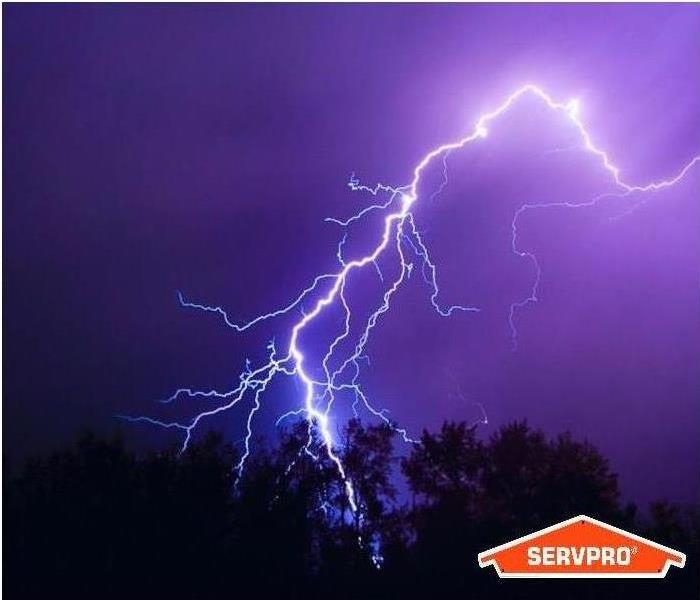 lightning storms and homeowners
lightning storms and homeowners
Happy January! it's that time of year again when the storms hit our areas and living in Southern California we are never really repaired.
Here are a few Tips to help you and your family.
1. Check roof tiles or shingles for wear and lifting to prevent costly leaks before a storm.
2. If the weather is warm turn the AC on and ensure your home is cold before the storm hits. Now if the weather is cold turn your heater up to stay warm! Inside temperature can last up to 48 hours.
3.Bring in your pets and if your pet is not an indoor pet try to bring them under a cover and somewhere they will stay safe!
4.Ensure all windows and doors are closed and locked!
5.Charge all your electronics prior to the storm because you are not sure how long you won't have electricity.
6. Keep candles and matches always for backup for when you lose light.
7. Make sure your freezer is closed tight! Freezer food will stay cold up to 3 days with a closed freezer door.
8. If the storm is serious and you have to evacuate bring anything memorable with you and if you can't do that pack it somewhere safe!
9. Create a home safety kit! Some things you can add are water bottles , flashlight , canned foods , first aid bag , tools!
10. The final tip is be sure to shut off any electronics that instantly uses electricity! The reason for this is when your power turns back on it can not be overloaded with things and there will be no risk for a fire or for it to burn out.
Now remember if you ever do find yourself stuck in a storm any of us at SERVPRO will be gladly to help! Stay Safe.
Storm safety
11/1/2021 (Permalink)
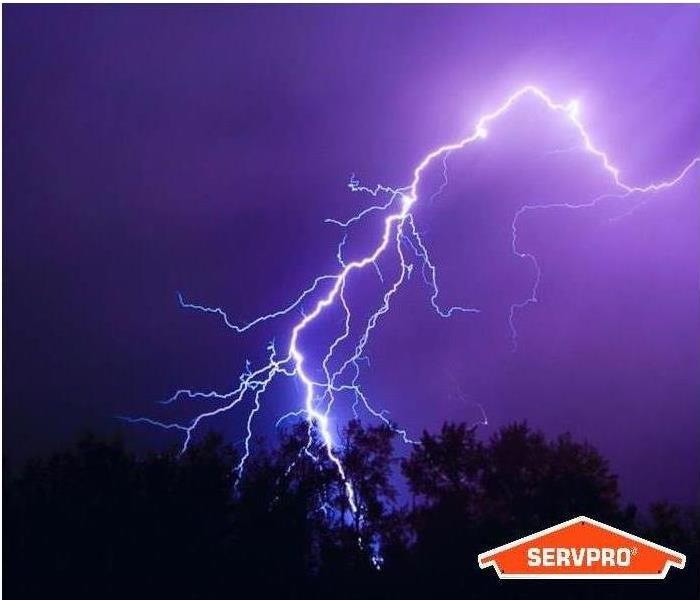 Storm
Storm
Here at SERVPRO we want you to have the proper information and be be prepared because you never know if you will find yourself dealing with a storm!
Some ways to be mindful and to be prepared for any storm starts with..
1. Stay inside! You do not want to be caught outside when any type of storm hits.
2. If the weather is warm turn the AC on and ensure your home is cold before the storm hits. Now if the weather is cold turn your heater up to stay warm! Inside temperature can last up to 48 hours.
3.Bring in your pets and if your pet is not an indoor pet try to bring them under a cover and somewhere they will stay safe!
4.Ensure all windows and doors are closed and locked!
5.Charge all your electronics prior to the storm because you are not sure how long you won't have electricity.
6. Keep candles and matches always for backup for when you lose light.
7. Make sure your freezer is closed tight! Freezer food will stay cold up to 3 days with a closed freezer door.
8. If the storm is serious and you have to evacuate bring anything memorable with you and if you can't do that pack it somewhere safe!
9. Create a home safety kit! Some things you can add are water bottles , flashlight , canned foods , first aid bag , tools!
10. The final tip is be sure to shut off any electronics that instantly uses electricity! The reason for this is when your power turns back on it can not be overloaded with things and there will be no risk for a fire or for it to burn out.
Now remember if you ever do find yourself stuck in a storm SERVPRO will be here and available to help! Stay Safe.
Lightning damage
2/18/2021 (Permalink)
Planning for a storm might feel overwhelming but If you don’t have a plan of your own, get one started today, and check out Emergency Lighting’s stock of smoke alarms, lights, and accessories made to get you through any emergency.
Key Testing Tips for Batteries and Bulbs
When testing your commercial emergency exit signs, there are two main components to check for full operation. Bulbs and batteries. These are the first things to review during scheduled maintenance tests. Fire code requires that all emergency lights and lighted exit signs be inspected at a monthly minimum.
Certain models will have two sets of bulbs that should be checked during these monthly tests. The first set runs on your 110 volt building power, and the second low voltage set comes on with a power failure. These low voltage bulbs are powered directly from the on board reserve battery. As a result, a sign that appears to be working may fail during a power outage because the low voltage bulbs have burned out.
Likewise, many defective batteries maintain just enough charge to light the bulbs for a few seconds after being triggered. If you don’t test reserve batteries for at least thirty seconds, you may find that the lights work each month only to find that they go out when you really need them. By testing the lights for at least thirty seconds you can make sure your batteries don’t just have a misleading surface charge.
Storm family safety
2/9/2021 (Permalink)
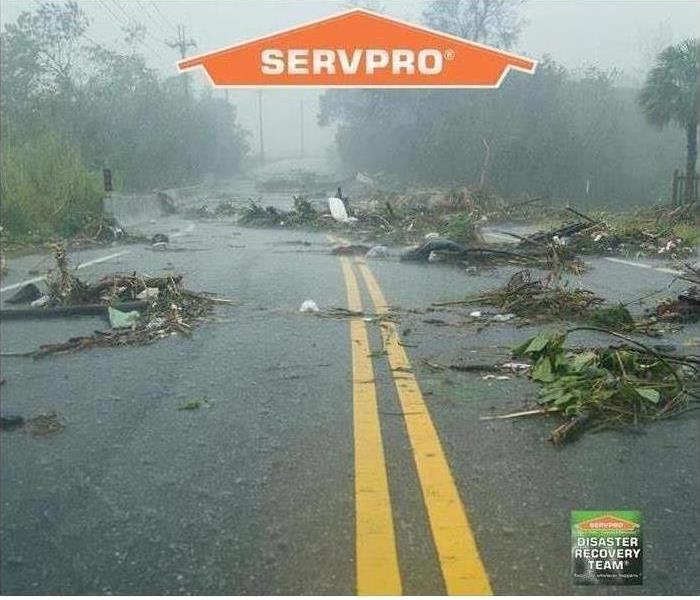
Protecting your home in a storm is important, these tips will come in handy to prepare you and for family for anything that comes your way
1.Modify your homes water valves. If the city's main sewer line gets backed up during a heavy rain storm, you could find yourself standing in a a puddle of you-know-what. You may want to consider installing a interior or exterior backflow valve. Backflow valves prevent your water system from being contaminated from water flowing backwards into your supply lines.
2.Clear gutter, drains, and downspouts. Clogged gutters and downspouts can end up in a messy flood. Take the time to clean them and clear them of any and all debris before the rain comes.
3.Cover air vents. One of the most common ways water fins its way into a home is through the home's air vents. If you know that heavy rain is in the forecast and that you are at risk of flooding, cover your air vents with thick plastic sheeting from both the outside and the inside.
4.Check your sealant surrounding doors and windows. Make sure that any gaps or holes in the sealant surrounding the doors and windows are filled in. This will help stop rain water from finding its way into your home.
Carbon monoxide in storms
2/8/2021 (Permalink)
Carbon monoxide (CO) poisoning deaths, caused by portable generators reportedly being used inside homes and/or garages, have been reported in Florida in recent days. In the aftermath of Hurricane Irma, there are widespread power outages. CPSC is warning consumers to take three critical precautions to prevent loss of life from poisonous carbon monoxide when using a portable generator:
1. NEVER use a portable generator inside your home. One portable generator can emit the same amount of deadly carbon monoxide gas as hundreds of mid-size cars. Just as you would not leave a car running in a closed garage, do not run a generator inside a garage, home, shed or near open windows or vents.
2. Portable generators need air and distance. Place generators OUTDOORS ONLY, at least 20 feet away from your home.
3. Carbon monoxide is called the “invisible killer.” This deadly gas is colorless and odorless and can quickly incapacitate and kill you and your family in minutes. A working CO alarm can detect high levels of the gas in your home. If it goes off, do not ignore it. Get out! Then call 911.
Do This:
•Test smoke and carbon monoxide alarms once a month to make sure they are working.
•Know the symptoms of carbon monoxide poisoning: headache, dizziness, weakness, nausea, vomiting, sleepiness, and confusion. If you suspect CO poisoning, get outside to fresh air immediately, and then call 911.
•Make sure portable fuel burning space heaters have an oxygen depletion sensor (ODS). An ODS shuts off the heater if oxygen levels start to fall to protect against CO poisoning.
•Open the fireplace damper before lighting a fire, and keep it open until the ashes are cool to avert the buildup of carbon monoxide, especially at night while families sleep.
Never Do This:
•Never use a gas oven or stove to heat your home.
•Never use kerosene space heaters in enclosed spaces; always properly ventilate.
•Never use portable generators inside the house, including in the basement, shed, or garage— generators should be outside at least 20 feet away from the house when in use.
•Don’t use charcoal or gas grills inside or operate them outside near open windows or doors.
Keeping your family safe during a storm
2/1/2021 (Permalink)
A THUNDERSTORM WATCH means a thunderstorm is possible for your area.
A THUNDERSTORM WARNING means a thunderstorm is taking place in your area.
IF YOU’RE OUTDOORS:
•Keep an eye at the sky. Look for darkening skies, flashes of lightning, or increasing winds. Lightning often proceeds rain, so don’t wait for the rain to begin. If you hear the sound of thunder, go to a safe place immediately.
•The best place to go is a sturdy building or a car, but make sure the windows in the car are shut. Avoid sheds, picnic areas, baseball dugouts and bleachers.
•If there is no shelter around you, stay away from trees. Crouch down in the open area, keeping twice as far away from a tree as far as it is tall. Put your feet together and place your hands over your ears to minimize hearing damage from thunder.
•If you’re with a group of people stay about 15 feet from each other.
•Stay out of water. It’s a great conductor of electricity. Swimming, wading, snorkeling and scuba diving are not safe. Also, don’t stand in puddles.
•Avoid metal. Stay away from clotheslines, fences, and drop your backpacks because they often have metal on them.
•If you’re playing an outdoor activity, wait at least 30 minutes after the last observed lightning strike or thunder.
IF YOU’RE INDOORS:
•Avoid water. It’s a great conductor of electricity, so do not take a shower, wash your hands, wash dishes or do laundry.
•Do not use a corded telephone. Lightning may strike exterior phone lines.
•Do not use electric equipment like computers and appliances during a storm.
•Stay away from windows and doors, and stay off porches.
IF SOMEONE IS STRUCK BY LIGHTNING:
•Call for help. Call 9-1-1 or send for help immediately.
•The injured person does not carry an electrical charge, so it is okay to touch them.
Storm Safety Kit
12/8/2020 (Permalink)
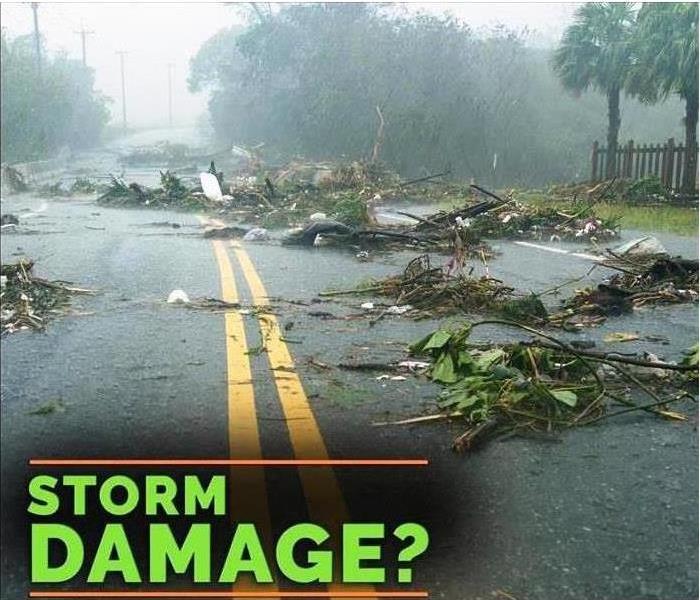 Storm Damage
Storm Damage
You never know when and where a storm will come. To be safe you always have to be prepared! A easy way to be prepared is to have a emergency kit for whatever type of storm may hit!
Some simple things you can add in for safety could be..
- A change of clothes
- Canned food! Can food will always be a positive thing to have because you do not know how long you will have to go being stuck in your home
- With canned food you should have a portable can opener
- A waterproof container to store your belongings
- Copies of important documents and papers
- A first aid safety kit for any injuries
- If you have any pets you will also need pet food
- A flashlight and also some candles along with matches
- Spare batteries
- And last but not least the most important thing is water
Staying Safe in a Storm
10/27/2020 (Permalink)
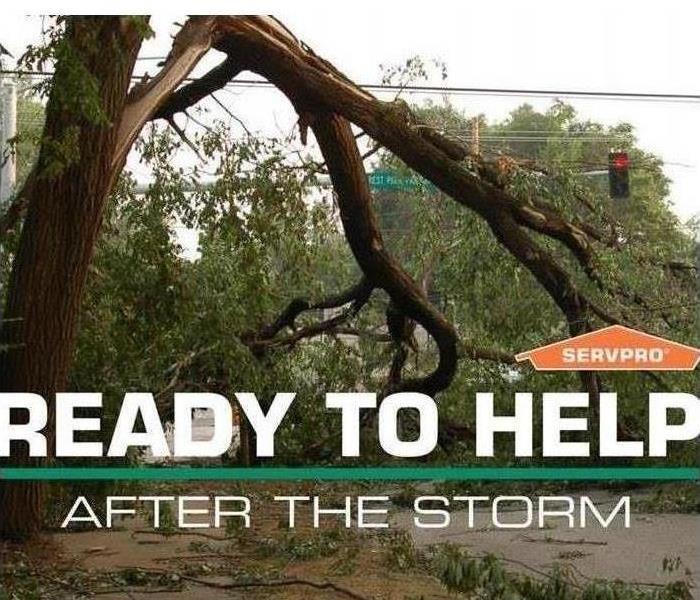 Storm Damage
Storm Damage
Here at SERVPRO we want you to always be prepared because you never know where you will be traveling and where you will find yourself dealing with a storm!
Some ways to be mindful and to be prepared for any storm starts with..
1. Stay inside! You do not want to be caught outside when any type of storm hits.
2. If the weather is warm turn the AC on and ensure your home is cold before the storm hits. Now if the weather is cold turn your heater up to stay warm! Inside temperature can last up to 48 hours.
3.Bring in your pets and if your pet is not an indoor pet try to bring them under a cover and somewhere they will stay safe!
4.Ensure all windows and doors are closed and locked!
5.Charge all your electronics prior to the storm because you are not sure how long you won't have electricity.
6. Keep candles and matches always for backup for when you lose light.
7. Make sure your freezer is closed tight! Freezer food will stay cold up to 3 days with a closed freezer door.
8. If the storm is serious and you have to evacuate bring anything memorable with you and if you can't do that pack it somewhere safe!
9. Create a home safety kit! Some things you can add are water bottles , flashlight , canned foods , first aid bag , tools!
10. The final tip is be sure to shut off any electronics that instantly uses electricity! The reason for this is when your power turns back on it can not be overloaded with things and there will be no risk for a fire or for it to burn out.
Now remember if you ever do find yourself stuck in a storm any of us at SERVPRO will be gladly to help! Stay Safe.

 24/7 Emergency Service
24/7 Emergency Service
